Swedish film and stage actress Ulla Jacobsson (1929-1982) achieved international fame with a nude scene in her second film, Hon dansade en sommar/One Summer of Happiness (1951). Another highlight was her serene performance in Bergman's Sommarnattens leende/Smiles of a Summer Night (1955).

German postcard by Rüdel-Verlag, Hamburg-Bergedorf, no. 548. Photo: Nordisk Tonefilm / Constantin-Film. Publicity still for Hon dansade en sommar/One Summer of Happiness (Arne Mattsson, 1951).
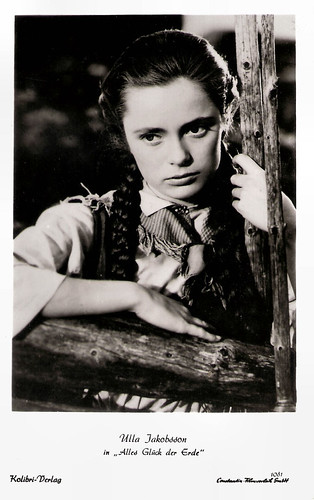
German postcard by Kolibri-Verlag, no. 1081. Photo: Constantin-Film-Verleih. Publicity still for All jordens fröjd/All the World's Delights (Rolf Husberg, 1953).
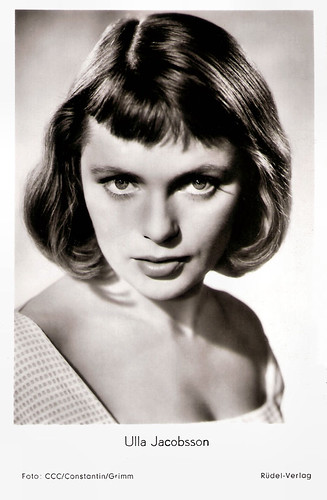
German postcard by Rüdel-Verlag, no. 1999. Photo: CCC / Constantin-Film / Grimm. Publicity still for Die Letzten werden die Ersten sein/The Last Ones Shall Be First (Rolf Hansen, 1957).
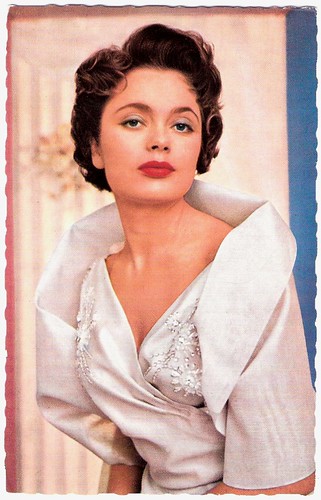
German postcard by Kolbri-Verlag, Minden/Westf., no. F 10. Retail price: 25 Pf. Photo: Constantin/Leonard. Publicity still for Die Letzten werden die Ersten sein/The Last Ones Shall Be First (Rolf Hansen, 1957).
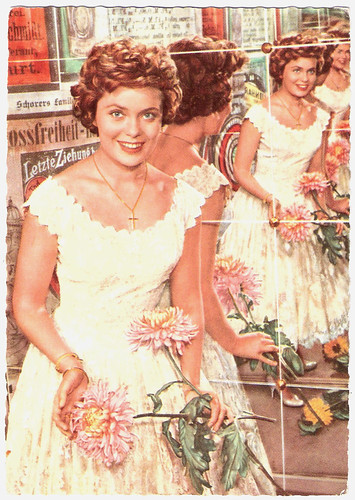
German postcard by Universum-film Aktiengesellschaft (UFA), Berlin-Templehof, no. CK-247. Retail price: 30 Pfg. Photo: Klaus Collignon.
Ulla Jacobsson was born in 1929 in Mölndal, a part of the Göteborg (Gothenburg) urban area on the west coast of Sweden. After her stage debut in Göteborg’s Stadsteater in 1947, she appeared in plays by Kaj Munk, Bertolt Brecht, Jean Anouilh, and William Shakespeare. She made her first film appearance in Bärande hav/The Seas We Travel (Arne Mattsson, 1951) with Alf Kjellin. Her second film with the same director, Hon dansade en sommar/One Summer of Happiness (Arne Mattsson, 1951), was presented at the Cannes Film Festival in 1951.
Based on the novel by Per Olof Ekstrom, the story revolves around the romance between 19-year-old student Goran (Folke Sundquist) and the 17-year-old farmer's daughter Kerstin (Ulla Jacobsson). A scene where Goran and Kerstin swim and embrace in the nude caused a sensation and made Jacobsson world-famous. In Cannes, the film won a prize for music and at the Berlin Film Festival, the film was awarded with the Golden Bear.
Next Jacobsson appeared in such Swedish productions as All jordens fröjd/All the World's Delights (Rolf Husberg, 1953), the August Strindberg adaptation Karin Månsdotter (Alf Sjöberg, 1954), and Herr Arnes penningar/Sir Arne's Treasure (Gustaf Molander, 1954). In Germany, she also appeared in films, including Die Heilige Lüge/Pious Lies (Wolfgang Liebeneiner, 1954) with Karlheinz Böhm, and Der Pfarrer von Kirchfeld/The Priest from Kirchfeld (Hans Deppe, 1955) with Claus Holm.
Another international hit was the comedy of manners Sommarnattens leende/Smiles of a Summer Night (Ingmar Bergman, 1955). Bergman's comic masterpiece opens with middle-aged lawyer Frederik Egerman (Gunnar Bjornstrand) again failing to consummate his marriage with the much younger Anne (Ulla Jacobsson). At IMDb, reviewer Clavallie writes: “Charming, light-hearted, delicate, and romantic are not the terms most people think to use when describing Bergman films, and yet Smiles of a Summer Night is all of these. This is one of the most sophisticated romantic movies ever filmed, and a pure delight. It is a clever and witty romance based on the classic elements of French farce. Simply wonderful.”
The film’s success started Jacobsson’s international career. In France, she starred in Crime et châtiment/Crime and Punishment (Georges Lampin, 1956), an updated version of Fyodor Dostoyevsky's story about the Nietzchean student Raskolnikov (Bernard Blier). In Germany, she appeared with O.E. Hasse and Maximilian Schell in Die Letzten werden die Ersten sein/The Last Ones Shall Be First (Rolf Hansen, 1957). That year she moved to Vienna, where she was offered an engagement at the Theater in der Josefstadt.

German collector card in the 'Filmgrössen aus aller Welt" series II. Ulla Jacobsson in Herr Arnes penningar/Sir Arne's Treasure (Gustaf Molander, 1954).

German postcard, no. 1048.
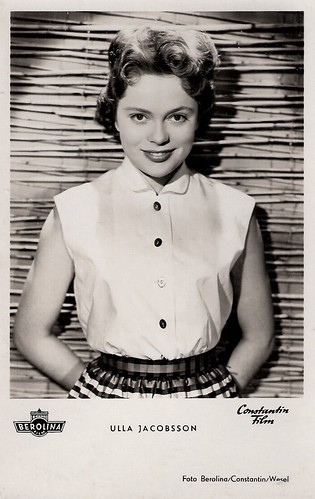
German postcard by Kunst und Bild, Berlin, no. A 1150. Photo: Berolina-Constantin-Wesel. Publicity photo for Und ewig bleibt die Liebe/Eternal Love (Wolfgang Liebeneiner, 1954).
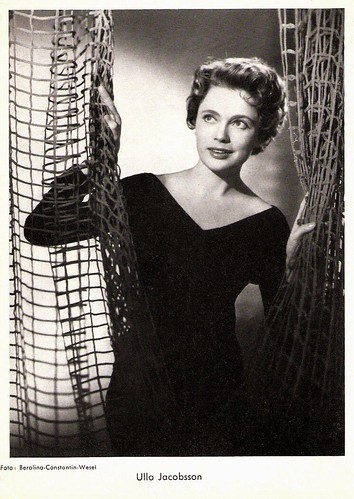
German collector's card. Photo: Berolina-Constantin-Wesel.

German postcard by Kolibri-Verlag, no. 1447. Photo: Berolina / Constantin-Film / Wesel. Publicity still for Die heilige Lüge/Saintly Lie (Wolfgang Liebeneiner, 1954) with Karlheinz Böhm.
In the early 1960s, Ulla Jacobsson started appearing in English-language films. She made one American film, the light romantic comedy Love Is a Ball (David Swift, 1963) starring Charles Boyer. At AllMovie, Hal Erickson writes: “The graceful and talented Jacobsson had to withstand an idiotic ad campaign which tried to redefine her as a Swedish ‘sex symbol’."
Normally she tended to play serious and anxious-looking characters. In Great Britain, she became better known for her part as the daughter of a missionary (played by Jack Hawkins) in Zulu (Cy Endfield, 1964). Filmed on a grand scale, Zulu is a rousing recreation of the 1879 siege of Rorke's Drift in Natal, Africa. An army of 4,000 Zulu warriors had already decimated a huge British garrison; and now threatened the much smaller Rorke's Drift with less than 100 British soldiers.
After this film, Jacobsson started hopscotching between Europe and England for the balance of her career. Other notable films include the war film The Heroes of Telemark (Anthony Mann, 1965) with Kirk Douglas, and La Servante/The Servant (Jacques-Paul Bertrand, 1970) with France Anglade. She won the Deutschen Filmpreis (German Film Award) for Supporting Actress for her part in Alle Jahre wieder/Next Year, Same Time (Ulrich Schamoni, 1967) with Sabine Sinjen.
She reunited with her first director, Arne Matsson for Bamse/My Father's Mistress (Arne Mattsson, 1970). Her last films were Wolfgang Petersen’s thriller Einer Von Uns Beiden/One or the Other (Wolfgang Petersen, 1975) with Elke Sommer, and Fassbinder’s Faustrecht der Freiheit/Fox and His Friends (Rainer Werner Fassbinder, 1975). The latter was the interesting and heartbreaking story of Fox, a gay sideshow worker (played by Fassbinder himself) who wins the lottery, only to be exploited to the hilt by his upper-class lover (Peter Chatel). Jacobsson played Chatel’s mother.
Later she only made a few more TV films, including the miniseries Das Ding/The Thing (Uli Edel, 1978). The reason for her retirement was that she had fallen ill. In 1982 she died from bone cancer in a hospital in her hometown Vienna. She was 53. Ulla Jacobsson was married three times. Her first marriage was to the Viennese engineer Josef Kornfeld, with whom she had a daughter, Ditte. Then she was married to Dutch painter Frank Lodeizen, with whom she had a son, Martin. Lodeizen’s daughter Rifka Lodeizen from a later marriage is now a well-known film actress in the Netherlands. Jacobsson finally married Austrian ethnologist Hans Winfried Rohsmann.

German postcard by WS-Druck, Wanne-Eickel, no. 33. Photo: Constantin / Wesel.
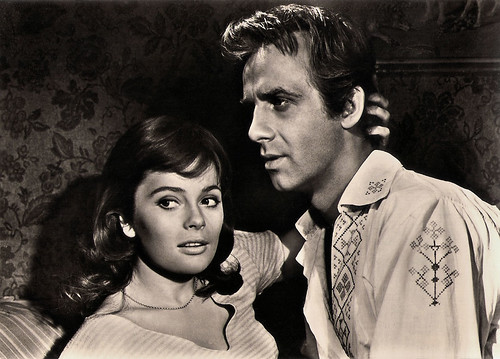
East-German postcard by VEB Progress Filmverlag, Berlin, no. 2.338, 1965. Photo: Ulla Jacobsson and Jarl Kulle in Sången om den eldröda blomman/Song of the Scarlet Flower (Gustaf Molander, 1956).

Romanian postcard by Casa Filmului Acin, no. 40. Kirk Douglas and Ulla Jacobsson in The Heroes of Telemark (Anthony Mann, 1965).
Trailer for Zulu (1964). Source: 05HK09 (YouTube).
Trailer for The Heroes Of Telemark (1965). Source: Sala de Exibição (YouTube).
Sources: Hal Erickson (AllMovie - Page now defunct), Rudi Polt (IMDb), Wikipedia (English, French and Swedish) and IMDb.
This post was last updated on 12 November 2024.

German postcard by Rüdel-Verlag, Hamburg-Bergedorf, no. 548. Photo: Nordisk Tonefilm / Constantin-Film. Publicity still for Hon dansade en sommar/One Summer of Happiness (Arne Mattsson, 1951).

German postcard by Kolibri-Verlag, no. 1081. Photo: Constantin-Film-Verleih. Publicity still for All jordens fröjd/All the World's Delights (Rolf Husberg, 1953).

German postcard by Rüdel-Verlag, no. 1999. Photo: CCC / Constantin-Film / Grimm. Publicity still for Die Letzten werden die Ersten sein/The Last Ones Shall Be First (Rolf Hansen, 1957).

German postcard by Kolbri-Verlag, Minden/Westf., no. F 10. Retail price: 25 Pf. Photo: Constantin/Leonard. Publicity still for Die Letzten werden die Ersten sein/The Last Ones Shall Be First (Rolf Hansen, 1957).

German postcard by Universum-film Aktiengesellschaft (UFA), Berlin-Templehof, no. CK-247. Retail price: 30 Pfg. Photo: Klaus Collignon.
Sensation
Ulla Jacobsson was born in 1929 in Mölndal, a part of the Göteborg (Gothenburg) urban area on the west coast of Sweden. After her stage debut in Göteborg’s Stadsteater in 1947, she appeared in plays by Kaj Munk, Bertolt Brecht, Jean Anouilh, and William Shakespeare. She made her first film appearance in Bärande hav/The Seas We Travel (Arne Mattsson, 1951) with Alf Kjellin. Her second film with the same director, Hon dansade en sommar/One Summer of Happiness (Arne Mattsson, 1951), was presented at the Cannes Film Festival in 1951.
Based on the novel by Per Olof Ekstrom, the story revolves around the romance between 19-year-old student Goran (Folke Sundquist) and the 17-year-old farmer's daughter Kerstin (Ulla Jacobsson). A scene where Goran and Kerstin swim and embrace in the nude caused a sensation and made Jacobsson world-famous. In Cannes, the film won a prize for music and at the Berlin Film Festival, the film was awarded with the Golden Bear.
Next Jacobsson appeared in such Swedish productions as All jordens fröjd/All the World's Delights (Rolf Husberg, 1953), the August Strindberg adaptation Karin Månsdotter (Alf Sjöberg, 1954), and Herr Arnes penningar/Sir Arne's Treasure (Gustaf Molander, 1954). In Germany, she also appeared in films, including Die Heilige Lüge/Pious Lies (Wolfgang Liebeneiner, 1954) with Karlheinz Böhm, and Der Pfarrer von Kirchfeld/The Priest from Kirchfeld (Hans Deppe, 1955) with Claus Holm.
Another international hit was the comedy of manners Sommarnattens leende/Smiles of a Summer Night (Ingmar Bergman, 1955). Bergman's comic masterpiece opens with middle-aged lawyer Frederik Egerman (Gunnar Bjornstrand) again failing to consummate his marriage with the much younger Anne (Ulla Jacobsson). At IMDb, reviewer Clavallie writes: “Charming, light-hearted, delicate, and romantic are not the terms most people think to use when describing Bergman films, and yet Smiles of a Summer Night is all of these. This is one of the most sophisticated romantic movies ever filmed, and a pure delight. It is a clever and witty romance based on the classic elements of French farce. Simply wonderful.”
The film’s success started Jacobsson’s international career. In France, she starred in Crime et châtiment/Crime and Punishment (Georges Lampin, 1956), an updated version of Fyodor Dostoyevsky's story about the Nietzchean student Raskolnikov (Bernard Blier). In Germany, she appeared with O.E. Hasse and Maximilian Schell in Die Letzten werden die Ersten sein/The Last Ones Shall Be First (Rolf Hansen, 1957). That year she moved to Vienna, where she was offered an engagement at the Theater in der Josefstadt.

German collector card in the 'Filmgrössen aus aller Welt" series II. Ulla Jacobsson in Herr Arnes penningar/Sir Arne's Treasure (Gustaf Molander, 1954).

German postcard, no. 1048.

German postcard by Kunst und Bild, Berlin, no. A 1150. Photo: Berolina-Constantin-Wesel. Publicity photo for Und ewig bleibt die Liebe/Eternal Love (Wolfgang Liebeneiner, 1954).

German collector's card. Photo: Berolina-Constantin-Wesel.

German postcard by Kolibri-Verlag, no. 1447. Photo: Berolina / Constantin-Film / Wesel. Publicity still for Die heilige Lüge/Saintly Lie (Wolfgang Liebeneiner, 1954) with Karlheinz Böhm.
Swedish sex symbol
In the early 1960s, Ulla Jacobsson started appearing in English-language films. She made one American film, the light romantic comedy Love Is a Ball (David Swift, 1963) starring Charles Boyer. At AllMovie, Hal Erickson writes: “The graceful and talented Jacobsson had to withstand an idiotic ad campaign which tried to redefine her as a Swedish ‘sex symbol’."
Normally she tended to play serious and anxious-looking characters. In Great Britain, she became better known for her part as the daughter of a missionary (played by Jack Hawkins) in Zulu (Cy Endfield, 1964). Filmed on a grand scale, Zulu is a rousing recreation of the 1879 siege of Rorke's Drift in Natal, Africa. An army of 4,000 Zulu warriors had already decimated a huge British garrison; and now threatened the much smaller Rorke's Drift with less than 100 British soldiers.
After this film, Jacobsson started hopscotching between Europe and England for the balance of her career. Other notable films include the war film The Heroes of Telemark (Anthony Mann, 1965) with Kirk Douglas, and La Servante/The Servant (Jacques-Paul Bertrand, 1970) with France Anglade. She won the Deutschen Filmpreis (German Film Award) for Supporting Actress for her part in Alle Jahre wieder/Next Year, Same Time (Ulrich Schamoni, 1967) with Sabine Sinjen.
She reunited with her first director, Arne Matsson for Bamse/My Father's Mistress (Arne Mattsson, 1970). Her last films were Wolfgang Petersen’s thriller Einer Von Uns Beiden/One or the Other (Wolfgang Petersen, 1975) with Elke Sommer, and Fassbinder’s Faustrecht der Freiheit/Fox and His Friends (Rainer Werner Fassbinder, 1975). The latter was the interesting and heartbreaking story of Fox, a gay sideshow worker (played by Fassbinder himself) who wins the lottery, only to be exploited to the hilt by his upper-class lover (Peter Chatel). Jacobsson played Chatel’s mother.
Later she only made a few more TV films, including the miniseries Das Ding/The Thing (Uli Edel, 1978). The reason for her retirement was that she had fallen ill. In 1982 she died from bone cancer in a hospital in her hometown Vienna. She was 53. Ulla Jacobsson was married three times. Her first marriage was to the Viennese engineer Josef Kornfeld, with whom she had a daughter, Ditte. Then she was married to Dutch painter Frank Lodeizen, with whom she had a son, Martin. Lodeizen’s daughter Rifka Lodeizen from a later marriage is now a well-known film actress in the Netherlands. Jacobsson finally married Austrian ethnologist Hans Winfried Rohsmann.

German postcard by WS-Druck, Wanne-Eickel, no. 33. Photo: Constantin / Wesel.

East-German postcard by VEB Progress Filmverlag, Berlin, no. 2.338, 1965. Photo: Ulla Jacobsson and Jarl Kulle in Sången om den eldröda blomman/Song of the Scarlet Flower (Gustaf Molander, 1956).

Romanian postcard by Casa Filmului Acin, no. 40. Kirk Douglas and Ulla Jacobsson in The Heroes of Telemark (Anthony Mann, 1965).
Trailer for Zulu (1964). Source: 05HK09 (YouTube).
Trailer for The Heroes Of Telemark (1965). Source: Sala de Exibição (YouTube).
Sources: Hal Erickson (AllMovie - Page now defunct), Rudi Polt (IMDb), Wikipedia (English, French and Swedish) and IMDb.
This post was last updated on 12 November 2024.
Wasn´t Ulla Jacobsson from Mölndal actually. That´s what I´ve heard and read in the local newspaper Mölndals-Posten. Anyway, a great actress. Thnx for this interesting blog! I´ll follow, ... :-)
ReplyDeleteHi Christian, Thanks for your comment. You're right, but Mölndal is a part of the Gothenburg urban area. I've changed it in the post. Greetings from Amsterdam, Bob
ReplyDeleteMonica and I are second cousins, Monica's mother and my mother were cousins.
ReplyDeleteJakob Larsson
Skövde Sweden
Sorry,
ReplyDeleteI meant Ulla and not Monica :-(